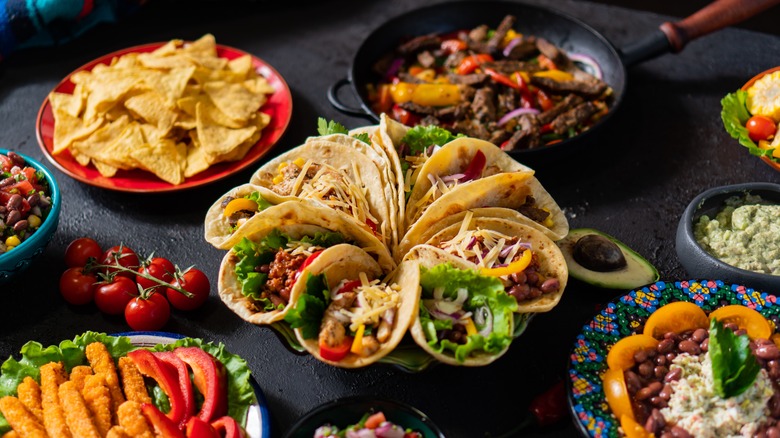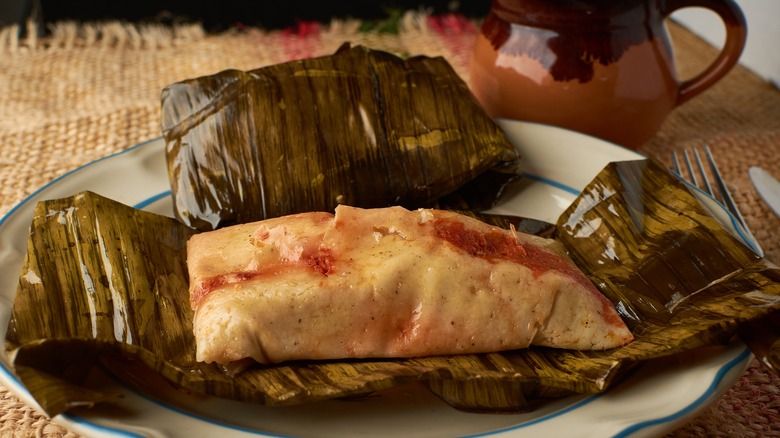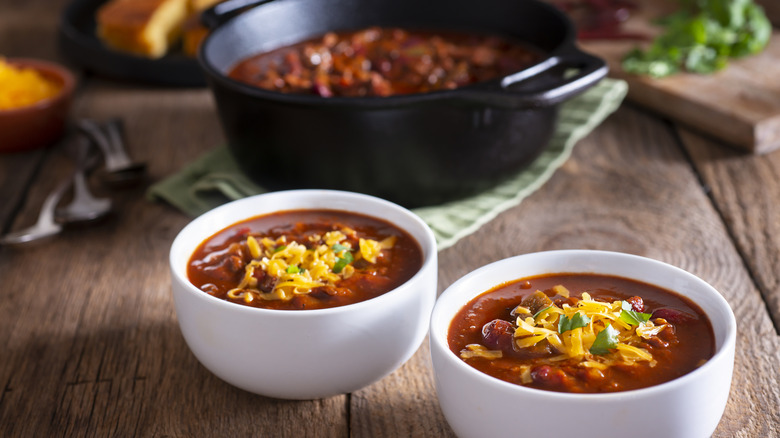The First Dishes That Defined Tex-Mex Cuisine
Emblematic of the melting pot that is the United States, Tex-Mex cuisine is native to one state in the country and heavily influenced by another country altogether. An early version of the term with no hyphen ("TexMex") was coined in 1875. It evolved to describe a few different subjects before it became the moniker of a hybrid of Mexican and Texan food, cooked and enjoyed by Texas' Tejano population (Texans with Mexican heritage).
Simply known as "Mexican food" to most of America before the 1970s, Tex-Mex encompasses dishes like nachos, fajitas, and enchiladas. However, chili con carne was the first dish to popularize the cuisine. During the 1880s, women known as "Chili Queens" sold the stew of red meat, peppers, and beans with a glass of water and a piece of bread for a dime. San Antonio's working class became frequent patrons, and following a growing demand for the regional dish, the Texas delegation at the 1893 World's Fair in Chicago, Illinois introduced chili con carne to the rest of the nation.
Since then, Texans have grown fiercely proud of their homegrown version of chili, and even President Lyndon B. Johnson once said that "Chili concocted outside of Texas is a weak, apologetic imitation of the real thing," (per Smithsonian Magazine). In 1977, Texas declared chili con carne its official state food, but other Tex-Mex dishes are nothing to sneeze at, both in terms of deliciousness and historical importance.
Tamales and the evolution of Tex-Mex
Following chili con carne, tamale recipes are the next-oldest Tex-Mex dish, although early versions can be traced back to the Aztec civilization. A labor-intensive dish, tamales were traditionally served during holidays like the Day of the Dead and Christmas, but they later became a popular street food sold by tamaleros, or tamale men. Tamales consist of a meat, vegetable, and/or cheese filling encased by masa (cornmeal) dough. They are then wrapped in banana leaves — or, more commonly in the U.S., corn husks — and steamed. A casserole version, tamale pie, is a distinctly Tex-Mex creation.
Author Diana Kennedy is credited with defining Tex-Mex as a separate American cuisine, distinguishing it from the traditional food prepared in Mexican kitchens. In her controversial 1972 cookbook "The Cuisines of Mexico," Kennedy, who lived in Mexico and taught cooking classes for decades, delineates between the recipes served south of the border and the cheesier, differently spiced "Tex-Mex" versions served up north.
Although she insulted a few Tex-Mex chefs along the way, Kennedy popularized Tex-Mex as a term, and educated Americans on the nuances of regional Mexican cuisine. Today, the Tex-Mex category is even more well-defined. While California's fish tacos and Arizona's deep-fried burritos, known as chimichangas, are commonly referred to as Tex-Mex cuisine, since they were not invented in the Lone Star state, they are in a different category. A few key traits of the Tex-Mex dishes themselves also define the cuisine.
Common elements of Tex-Mex
Compared to the flavors of dishes found in Mexico, Tex-Mex staples like chili con carne are heavily flavored with cumin, a smoky spice that was brought from the Canary Islands by San Antonio settlers in the 1500s. In 1893, German immigrant and San Antonio transplant Willie Gebhardt created a dried chili powder that made chili and other Tex-Mex recipes easier to prepare. This mix contained ancho chilis, cumin, oregano, and black pepper, and these flavorings are still widely used in Tex-Mex cooking.
There are countless regional variations of chili, and many Texans argue that true chili con carne should not contain beans. The smoky dish uses chunks of beef (like a boneless chuck roast), onion, tomato, spicy chiles, and the aforementioned spices (though the spice mix depends on the recipe). It's meant to be cooked slowly, allowing the cuts of beef time to break down into a tender stew.
Chili con carne is often garnished with fresh cilantro, cheese, diced avocado, and sour cream, yet more ingredients commonly found in Tex-Mex cuisine. Similarly, there are many filings for tamales. A beef filling is traditional, but you may find tamales with black beans, green chiles, chorizo, chicken, and more. Tex-Mex may have some basic traits that fans and cooks are loyal to, but the cooking style itself is an adaptation of multiple culinary influences, so feel free to experiment with the flavors and recipes of this delicious hybrid cuisine.



